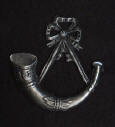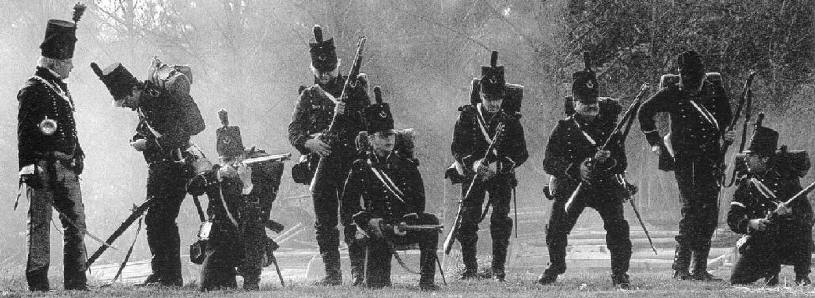|
A brief biography of William Wood
According to
his tombstone, William Wood was born about 1788, place of birth uncertain. At the age of 16 he joined the 2nd
battalion of the 95th Regiment (the Rifle Corps). The 2nd
95th saw considerable action with varying success. In 1807, they
fought the Spanish at Monte Video.
|

2/95th hat badge |
In 1808, they had to retreat from
Napoleonís army at Corunna in North West Spain and, in 1809, they also had
to retreat after the Walcheren Expedition in the Netherlands. Walcheren
Island was swampy and about 4,000 of the troops died of malaria compared
with 106 in actual battle. The rifle corps made a name for itself in the
1815 Battle of Waterloo where they distinguished themselves by being
instrumental in the victory.
|

Waterloo medal |
|
 |
Re-enactment
of 2/95th
In action
From the 2/95th Re-enactment Group www.95th-rifles.co.uk |
|
During his time with the 2/95th he had
frequent bouts of illness which could have been due to either malaria caught
at Walcheren or injuries suffered on the ill-fated retreat from Corunna.
He was discharged from
the 2/95th in September 1818 and re-enlisted in the Royal Staff
Corps six years later in September 1824. During that time it appears that he
married Ann Payler, had two children, Mary Ann and James, and learned
shoemaking as a trade.
In July 1825, William and
his brother Thomas sailed for New South Wales as Escort to Governor
Darling. After his arrival, he was sent to King George Sound in Western
Australia to establish a military and penal colony at Frederickstown, now
Albany. About a year later he was joined by his wife and two children, who
arrived together with Thomasí wife Sarah and their children.
|
|
.jpg)
William and Ann |
William and his family
returned to Sydney in December 1828 and
settled in Liverpool. In 1829, Governor
Darling ordered that men of the Royal Staff Corps could be discharged from the army and settle in Australia. Those
doing so would be given a parcel of land large enough to build a town on, a
yearís provisions, a collection of tools to help them get started and build
a hut, and a cow. To get title of the land, they had to remain on it and
cultivate it for seven years. William availed himself of this and was
granted some land in Liverpool. After much toing and froing and uncertainty,
he seems to have sold it and, instead, obtained 80 acres of land at Bong
Bong in 1839 (Rifle Farm), now a polo field stretching between the
Wingecarribee River to Eridge Park Rd. Here he raised the remainder of his
family. He and Ann are buried at the local Christ Church.
There is ambiguity in the documentation, and
it is possible that the 1929 Liverpool land did not involve our William
Wood, and his initial grant was at Bong Bong and title passed to him in 1839
after living there for up to ten years. |
Sources:
1. War Office records for the Public Records Office, Kew UK - Research for the
Wood family by Colonel Iain Swinnerton
2. John Passmore: Descent - vol 7 part 1 September 1974, Society of Australian
Genealogists: The Royal Staff Corps Settlers in Australia 1829
3. The Bridge at Bob's Creek - newsletter from David Wood
4. The Military Establishment at King George Sound J Sweetman, Military
Historical Society of WA, 1989.

|